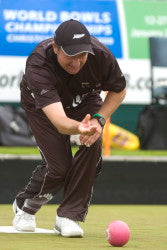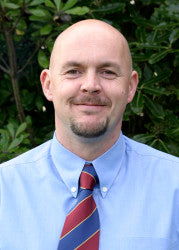World Bowls Championship 2008 A Greenkeeper’s Perspective
 During January the 2008 World Bowls Championship was held in Christchurch for the first time. This event is held every four years and 28 qualifying countries were represented. The tournament was hosted by three clubs within close proximity of each other - Burnside Bowling Club, Fendalton Bowling Club and Bowls Papanui.
During January the 2008 World Bowls Championship was held in Christchurch for the first time. This event is held every four years and 28 qualifying countries were represented. The tournament was hosted by three clubs within close proximity of each other - Burnside Bowling Club, Fendalton Bowling Club and Bowls Papanui.
Burnside Bowling Club was selected as the headquarters and hosted the finals of the event - this is a three green complex which regularly hosts national and international competition. Fendalton Bowling Club also offered a three green venue, including the Dorchester Green, the home of Bowls Canterbury. The two green complex of Bowls Papanui was the third selected venue for the event. All greens used for the championships have a cotula maniototo surface.
The three greenkeepers responsible for maintaining the greens were Ken Prebble of Burnside, Ron Sabin of Bowls Papanui and Ken Thickett of Fendalton. Preparation for the tournament commenced at least three years prior to the event, when the number three green at Burnside was re-surfaced in preparation for hosting the championship finals. From that time on, and intensifying in the months leading up to the tournament, the three greenkeepers worked closely, with the aim of achieving consistent greens at all venues with a speed of between 15-17 seconds.
Picture Left-Gary Lawson, the World Pairs and Fours Champion, was in fine form at the World Bowls Championships in Christchurch during January.
Potash, with accompanying applications of liquid iron, was applied to the greens prior to and early into the playing season. In early December, further hardening agents were used. This generally included Iron sulphate, magnesium sulphate and Liquid Potassium (potassium carbonate). These applications were made to harden the plant as much as possible in preparation for the forthcoming championships. This application was repeated in late December/early January.
A preventative fungicide (Amistar) was applied prior to the championship, as was Chlorpyrifos to help control the ever-present cotula weevil.
Pre-tournament preparation went smoothly at all venues with one exception. Ron had noticed that one of his greens had started to slip back, was beginning to show fine cracks in places and down one side of the green had started to pull away from the plinth board. After checking the irrigation system Ron found the system was working, but had lost a considerable amount of pressure. Having made a few more enquiries he was told the water main had been turned off by workmen to fix one of the clubs water fountains. Further investigation of the water main bought to light that it had only been turned back on about half way, which resulted in the water pressure only being half of what it should have been.
To re-establish the moisture levels, Ron flash flooded the green three nights in a row. The day after the second flood the temperature reached the high of 36°C. This goes to show that despite the best preparation, unforeseen events occur. Fortunately during the championships it all went according to plan and it was simply a matter of maintaining the well-prepared surfaces.
Picture right -Left to right: Ken Thickett - Fendalton Bowling Club, Ron Sabin - Bowls Papanui & Ken Prebble - Burnside Bowling Club
Mowing frequency varied from venue to venue. Papanui was not mown at all during the tournament, while some of the greens at the other two venues were mown once or twice during the tournament, depending on growth and speed. Cutting heights were between 32 and 35/1000 of an inch (approx. 0.8mm).
The excessive heat during the tournament did occasionally lead to what some would consider drastic measures. One afternoon the temperature reached around 35°C. Ken Prebble popped the irrigation heads and syringed the greens to cool the surface temperature. "I had to turn the water on to keep the greens alive. We have 18 days continuous play here, I couldn't afford to risk losing a green for the sake of 5 minutes watering. The players understood this was necessary in the extreme heat", said Ken.
The tremendous amount of wear in these hot conditions also prompted a request from Ken Thicket at Fendalton. "During the heat I also had to syringe the greens and asked the players if they could please keep the leads and seconds off the green as this would reduce the stress. Many of the players obliged and fully understood." Ken added, "This isn't like other play where the leads and seconds often stand on the surrounds. These players stand on the green at all times when playing; that's a lot of wear".
Volunteer help was invaluable during the event, as there is little time to set up the rinks, roll the green and cut if needed. Ron stated, "The volunteer help was fantastic. I had 10 guys running around, setting up rinks, marking lines etc. They turned up on the dot every day. It all ran like clockwork". All three greenkeepers agreed they felt a great deal of stress and worry prior to the event and a great sense of relief once play actually commenced.
 As green speed had to remain consistent during play, irrigation had to be applied lightly, rather than in one large application as this would not only slow the surface, but would also create playing conditions which differed from the previous day. Two short cycles at 10.00pm and 1.00am were usually applied each evening. Due to the amount of wear at the ends and hot dry conditions, the nightly irrigation had to be supplemented by selective hand watering of the ends; up to the 2m mark when required.
As green speed had to remain consistent during play, irrigation had to be applied lightly, rather than in one large application as this would not only slow the surface, but would also create playing conditions which differed from the previous day. Two short cycles at 10.00pm and 1.00am were usually applied each evening. Due to the amount of wear at the ends and hot dry conditions, the nightly irrigation had to be supplemented by selective hand watering of the ends; up to the 2m mark when required.
Picture left- Val Smith in gold medal winning form takes World Singles and Pairs Championship titles.
Following the tournament the recovery plan was to rest the greens and the sore heads of the greenkeepers involved. Of most importance was to flood the greens to re-establish moisture levels and raise cutting heights. Burnsides third green, which hosted the finals, was showing signs of wear and surface cracking. The day immediately after the finals the green was spike rolled to facilitate water entry, followed by flooding. 
The championships were a huge success, both in terms of the event and the success enjoyed by the NZ team. There was praise in abundance from the participating players, many of whom from overseas had never experienced greens with good speed and a true surface, which maniototo offers.
Despite the hard work and stress involved the greenkeepers thoroughly enjoyed being involved in such a huge event. Ken Prebble said, "It's been good, a pleasure to be involved; all the pre tournament worry didn't eventuate. I wouldn't have missed it for the world". Ken Thickett concurred with this comment adding, "This tournament has been the hardest I have done, much harder than the two Champion of Champions and the Asia Pacific, mainly due to the hot weather. Though, all the hard work was worth it, I can't wait till the after tournament function". Ron added, "It's been fantastic, one of the best things though was meeting some fantastic people from all over the world. They have been unbelievable".
Picture right -Paul Avison Agronomist NZ Sports Turf Institute Christchurch
Source :- article published curtesy of New Zealand Turf Management Journal www.nzsti.org.nz/
